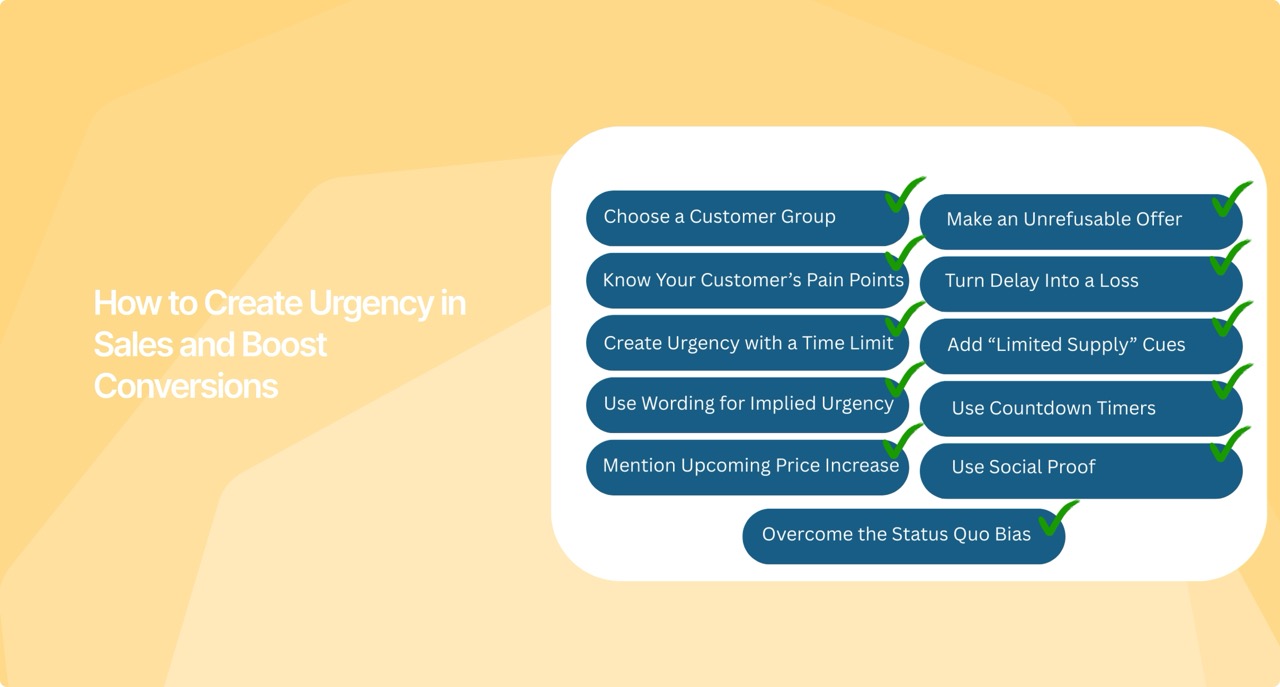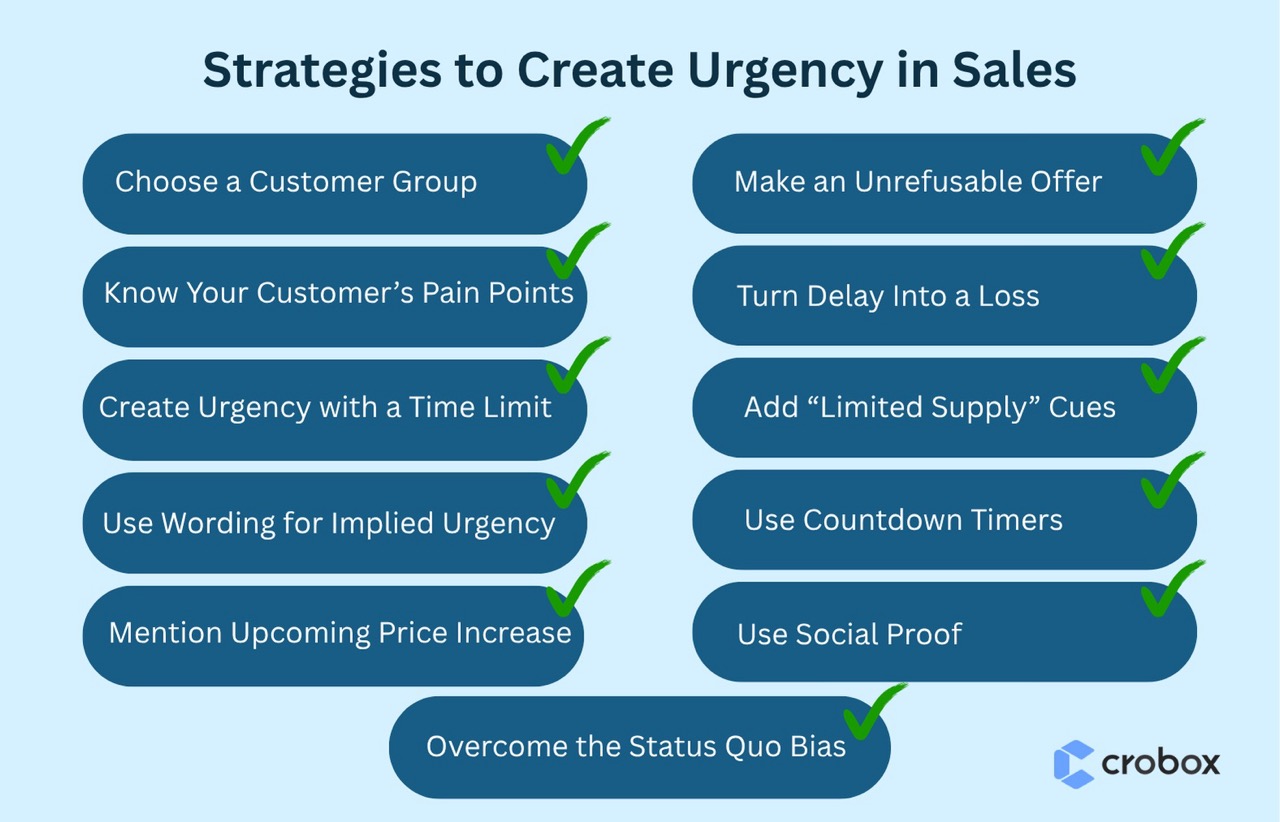
Some online shoppers act the moment they see something they like, while others often hesitate, scrolling, thinking, and eventually walking away. Usually, the difference comes down to one powerful psychological trigger: urgency.
In fact, studies show that limited-time offers and CTAs can increase conversion rates by as much as 332%. Why? Because creating a sense of urgency in sales taps into the fear of missing out (FOMO), making customers feel like they need to act now, or risk losing out.
In this blog post, you will explore how to create urgency in sales using behavioral psychology, practical tactics, and intelligent technology like Crobox’s Dynamic Messaging. You have the opportunity to discover step-by-step strategies and proven examples that demonstrate how to build urgency in sales without compromising trust or user experience.
Creating urgency in sales is the strategic use of psychological triggers, such as scarcity, time limits, or competition, to motivate customers to act quickly. It taps into one of the most primal human instincts: the fear of missing out (FOMO).
The power of urgency lies in its ability to overcome hesitation. Even the most interested customers can get distracted, overwhelmed with options, or second-guess their choices. Urgency cuts through that noise by giving shoppers a reason to take action now, even if it comes to a flash sale, low-stock alert, or limited-edition release.
When urgency is authentic, relevant, and timed correctly, it boosts:
Urgency is one of the few strategies that aligns buyer psychology with business goals. When paired with the right tools like Crobox’s Dynamic Messaging, it becomes even more effective.
While creating urgency in sales can significantly boost conversions, when done poorly, it can backfire, damaging trust, frustrating customers, and even hurting your brand’s long-term reputation.
Here are the most common pitfalls to avoid if you ask yourself how to create urgency in sales:

Learning how to create urgency in sales means tapping into consumer psychology to inspire faster, more confident decisions, without crossing the line into pressure selling. These 11 tactics are designed for modern eCommerce teams and can be implemented with ease, especially when using tools like Crobox and behavioral targeting capabilities.
Tailor urgency strategies to the audience you are targeting. First-time visitors may need softer nudges like “Limited-time welcome offer,” while returning shoppers respond better to FOMO triggers like “Others are viewing this item now.” Use segmentation tools to assign urgency messaging based on behavioral profiles and lifecycle stage.
Effective urgency should solve a real problem. If your audience is price-sensitive, emphasize limited-time discounts. If they value exclusivity, highlight limited edition products. Understanding these pain points allows you to position urgency as helpful guidance rather than a pushy sales tactic. Use surveys, on-site behavior, or chat logs to gather this insight.
A visible deadline can turn passive browsing into action. You can focus on a 48-hour sale or a countdown to a product drop, using real timers, not artificial ones. Integrate these limits into banners, email subject lines, and even checkout messages to create consistent urgency throughout the journey.
Language like “Act fast,” “Last chance,” or “Selling quickly” works well even without a literal deadline. These subtle signs build tension and anticipation. Test them in button copy, email headers, and product descriptions to see what resonates best with different segments of your audience.
People are motivated to buy now if they believe the price will go up later. Highlight this clearly: “Prices go up next week,” or “Early bird pricing ends Friday.” Combine this tactic with personalized reminders, like cart abandonment emails that restate the price hike, to double its impact.
Offer irresistible deals with a short shelf life. For example, “Buy One, Get One for 24 hours only” or offer a high-value bundle exclusive to subscribers - the key is limited availability. Use Crobox’s Dynamic Messaging to trigger these offers during high-intent moments, such as after product discovery or just before checkout.
Frame your offer in terms of loss rather than gain. Instead of “Buy now to save $20,” try “You will miss $20 in savings if you wait.” Loss aversion is a powerful psychological principle, and it is even more effective when you personalize it based on cart value or viewing history.
Inventory scarcity makes products feel more desirable. Phrases like “Only 2 left” or “Low stock in your size” can dramatically increase urgency, especially when displayed on PDPs and during the checkout process. Use real-time inventory data, and automate this messaging with Crobox to keep it accurate and effective.
Countdowns are one of the most direct ways to show urgency. A ticking clock on a promo page or in a checkout bar adds real pressure. Boost this by showing a clear benefit tied to the timer: “2h 43m left to get 15% off.” Ensure timers are synchronized across devices to avoid confusion.
When people see that others are taking action, it removes hesitation. Add real-time notifications like “Alex from London just bought this” or show product reviews sorted by most recent purchases. For higher-value products, include short customer stories or video testimonials that emphasize speed-to-purchase decisions and satisfaction.
People resist change even if it benefits them. Use urgency to position your offer as a rare window of opportunity. “Why wait?” or “Today is the best time to switch” messages help shoppers reframe indecision as a risk. Crobox can dynamically tailor these signs based on a user’s browsing history or hesitation points.
Creating a sense of urgency in sales is not about pressure, but about timing, relevance, and psychology. If you use it strategically, urgency motivates action, shortens the customer decision cycle, and significantly boosts conversion rates. From countdown timers and limited-time offers to personalized, behavior-driven messages, the key is to be authentic and data-driven.
With tools like Crobox’s Product Finder and all its AI-powered features, eCommerce brands can implement urgency tactics that feel natural and helpful, tailored to each shopper’s journey. If you are ready to turn hesitation into action and optimize your conversion strategy with personalized urgency signals, book a demo with Crobox today and see how the miracle happens.
To create urgency without sounding pushy, use authentic language and focus on the value for the customer. Highlight benefits, timelines, or limited availability in a helpful, informative tone.
Effective techniques to create urgency in sales include time-limited offers, scarcity cues (like “Only 3 left!”), countdown timers, price increases, and personalized dynamic messages.
The limited-time offers activate FOMO (Fear of Missing Out), creating a psychological trigger that encourages faster decision-making and reduces cart abandonment.
Yes, urgency tactics can be used in B2B sales, but with nuance. Highlight deadlines related to procurement cycles, budget planning, or seasonal business needs to add relevance and urgency.
FOMO taps into emotional decision-making, motivating customers to act now to avoid missing a great opportunity or deal.
Yes, countdown timers are effective when used authentically. They create visual urgency and show deadlines, leading to significantly higher conversion rates.
When using scarcity in eCommerce, be transparent. If an item is truly low in stock or a deal is genuinely ending soon, communicate that honestly to maintain customer trust.
To measure your effectiveness of urgency in sales, track key metrics like conversion rate, time-to-purchase, cart abandonment rate, and A/B test performance of urgency elements like timers or limited-offer copy.